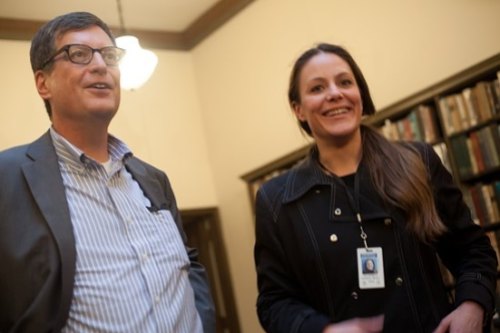Authorities have arrested and are preparing to charge the Rhode Island suspect in the alleged terrorist plot that ended in the shooting death of a Boston man last week. News organizations that had been withholding his name are now identifying him. The Boston Globe, for instance, reports that he is Nicholas Rovinski, 24, of Warwick, Rhode Island.
As I wrote last week for WGBH News, identifying a “person of interest” who has not been charged — and who may not be charged — is an ethically dubious practice. My views are informed by what I learned in researching my book “The Wired City.” Among the stories I reported on was the New Haven Independent’s decision not to name the likely suspect in the murder of a Yale graduate student until after he had been formally charged. Independent editor Paul Bass spoke with my Northeastern ethics students about the case in a conference call earlier this week.
What follows is an excerpt from “The Wired City,” taken from a longer excerpt published by the Nieman Journalism Lab.
***

Annie Le
On Monday, Sept. 14, 2009, six days after Annie Le had been reported missing, the Independent became the first to reveal that police had identified a 24-year-old laboratory technician who had worked with Le as a “person of interest.” The New Haven Register’s website followed shortly thereafter. And so began one of the more curious side stories of the Annie Le case.
As law enforcement officials continued with their investigation on Tuesday, neither the Independent nor the Register released the name of Le’s coworker. On Tuesday night, though, the police department held a news conference and announced that the “person of interest” was Raymond Clark, whose name was included in a press release. Because the news conference was covered live by a number of television stations, Clark’s identity immediately became public. On Wednesday, the Register named Clark and interviewed people who knew him. “I’m in total shock,” an unidentified high school classmate was quoted as saying. “He was the nicest kid — very quiet, but everyone liked him. I can’t believe he could do this. I’m sick to my stomach.” But the Independent continued to withhold Clark’s name.
The Independent’s managing editor, Melissa Bailey, was at the news conference too. She took notes and shot some video of New Haven Police Chief James Lewis speaking to reporters. But neither her story nor her video used Clark’s name. Bailey wrote, somewhat cryptically, “Police named the target of the search, calling him a ‘person of interest.’” Nor did the Independent identify Clark on Wednesday — and not even in a story posted early on Thursday morning reporting that police had staked out a motel where Clark was staying the night before, although it did link to a Register story that identified Clark in its lead paragraph. It wasn’t until later on Thursday morning that the Independent finally named Raymond Clark as the person police believed had murdered Annie Le. The reason: by then Clark had been arrested and charged, and was being taken into court for a formal arraignment.
The Independent’s refusal to name Clark until he had been formally charged was an admirable exercise in journalistic restraint. The decision derived in part from Bass’s institutional memory. In 1998, police had mistakenly identified a Yale professor as a “person of interest” in the murder of a student named Suzanne Jovin. No evidence against the professor was ever made public, and the murder was never solved. (In 2013, Yale and the city of New Haven announced a settlement with that wrongly accused professor.) Essentially, though, this restraint was a statement of Bass’s sense of how a news organization ought to serve the community
Judging by comments posted to the Independent, many readers appreciated Bass’s decision. “Thank you for the good sense to not publish his name at this time,” wrote “asdf” on Tuesday evening, after Clark’s name had begun to leak out but before the police had named him. The commenter added: “I really don’t understand what there is to gain by releasing his name — if you don’t have enough evidence to arrest him, then you don’t have enough evidence to smear him in the media.” Then there was this, from “LOOLY,” posted on Wednesday morning, after Clark’s name had been widely reported: “It should really be very simple. Unless he is being charged his name should not be used.”
Bass also had to make several other difficult decisions about identifying people connected to the Annie Le story. On Sept. 14, as Clark’s name was leaking out, the media converged on his apartment in Middletown, northeast of New Haven. Christine Stuart, who runs the political website CT News Junkie and contributes to the Independent, noticed the name of a woman along with that of Raymond Clark. She passed it along, and Melissa Bailey started plugging it into various social-networking sites. It didn’t take long before she found a public MySpace page for the woman, who turned out to be Clark’s 23-year-old fiancée. Bailey captured a screen image before the page could be taken down — which it soon was.
Bailey wrote a story that began, “The target in the slaying of Yale graduate student Annie Le had something in common with the victim — he, too, was engaged.” And she quoted the young woman as writing of Clark: “He has a big heart and tries to see the best in people ALL THE TIME! even when everyone else is telling him that the person is a psycho or that the person can’t be trusted. he thinks everyone deserves a second chance.” The woman’s name and photograph wound up being published by other news outlets, but it never appeared in the Independent.
That was not the Independent’s only social-networking scoop. In nearby Branford, Marcia Chambers of the Branford Eagle, a community news site that is affiliated with the Independent, was working her sources. Somehow she obtained a 2003 police report about an ex-girlfriend of Raymond Clark who claimed he had forced her to have sex when they were both students at Branford High School. As a condition of receiving the report, Chambers promised not to publish it until after an arrest had been made. But that didn’t mean there were not other uses to which the report could be put. Bailey typed the woman’s name into Facebook, discovered that she had an account, and friended her, letting her know she was a reporter covering the murder. After Clark’s arrest, Bailey and Chambers wrote a story without using the woman’s name. “I can’t believe this is true,” they quoted the woman as writing on her Facebook page. “I feel like im 16 all over again. Its jsut bringing back everything.”
The revelation that the Independent had the police report created a media stampede, Bailey said later. “People were calling us, begging us for this police report,” she told a researcher for Columbia University. “The New York Times came in and practically tried to arm-wrestle Paul.” The Independent withheld the fiancée’s name, a decision Bailey wrote that she had no misgivings about even though the woman later appeared on network television and identified herself.
By declining to name Raymond Clark until he had actually been charged with a crime, and by withholding the identities of the two women, Paul Bass had made a statement about what kind of news organization he wanted the Independent to be and what kind of journalism his community could expect from the site. Protecting the two women at a time when only the Independent knew who they were was the more straightforward of the two decisions. Any news executive who cares about journalistic ethics — or, for that matter, basic human decency — might have made the same call. But keeping Clark’s name off the site even after the New Haven police had put it in a press release, and even after the police chief had freely discussed it at a news conference — well, that was an extraordinary decision. Many journalists would argue that a news organization has an obligation to report the name of someone who might soon be charged with murder when the police have very publicly placed that name on the record. But Bass clearly has a different way of looking at such matters.
Weeks later, in a conversation at his office, Bass wondered if he had done the right thing while simultaneously defending his decision. “I still believe it’s a complicated question. I still believe we could definitely be wrong,” he said. Yet, as he continued, he didn’t sound like someone who thought he might be wrong, even as I suggested to him that his decision to withhold Clark’s name could be seen as something of an exercise in futility. “I’m in no way moving toward the idea that we should have run the name. I see no reason for putting the name out sooner. Nothing served,” he said. “I agree with you that it was futile. The name was out there. But we are still a news organization with standards.”
Those standards, I came to realize, are rooted not just in Bass’s view of journalism but in his sense of place, and even in his spiritual beliefs. The Independent is a news site, but it’s not just a news site. It is also a gathering place, a forum for civil discussion of local issues, and a spark for civic engagement. It is a mixture that reflects Bass’s interests: a multifaceted approach to community journalism — to community and journalism — that has been visible in his life and work from the time he began writing about New Haven.
Also published at WGBHNews.org.











